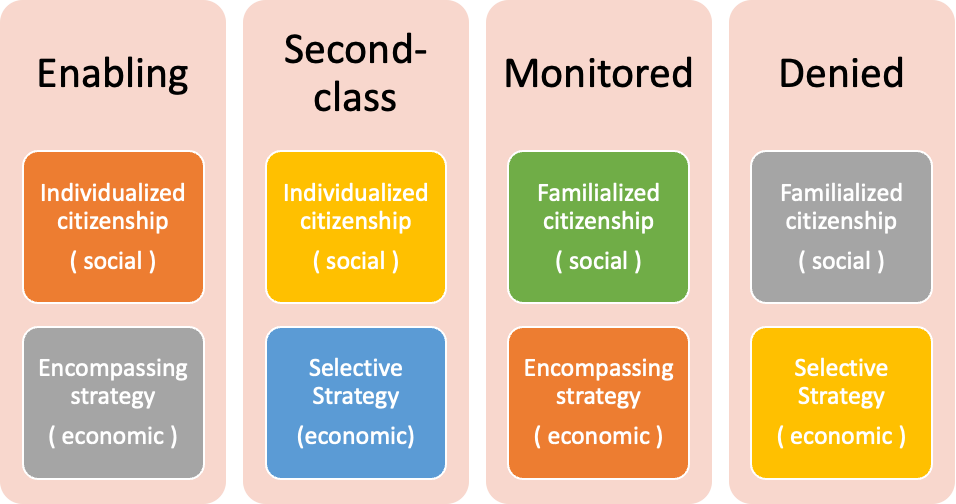Themes: Citizenship
Objectives
- To make participants understand about the challenges of the citizenship practices
- To increase the knowledge of the youth workers for tackling with failure the social welfare structure
- To increase the participants knowledge about the approaches to youth citizenship
Duration and Planning
- 15 minutes : Rights & Citizenship
- 40 minutes : Youth Citizenship Models
- 10 minutes : Debriefing
Materials
- Flipchart
- Board Markers
Recommended Method
After the continuation of the previous day, the facilitator presents the model of T.H. Marshall concerning to the rights and citizenship. During the presentation, the participants are asked questions concerning to each right areas and the relation with the right areas of the young person’s experiences to initiate a discussion.

In the second stage, the participants work on the differences of their countries concerning to each right area, they are allowed to use the internet or the resources that are developed within the project indicated in readings section. The facilitator tells the participants to find out :
- Information concerning to the participation related with political rights
- Information concerning to the housing, health, education, employment related with social rights
- Information concerning to the right to associate, freedom of speech, freedom of religion etc. related with civic rights
After the finalisation of the presentations, the facilitator provides information concerning to the each right area by referring to “The Voices of Young People and Youth Trajectories in Southern Europe” findings. After the closure of the session, the participants provided with the model developed by Chevalier depending on the social and economic citizenship of young people as below :

Later on, the participants are asked to classify the countries involved in the project ( Portugal, Spain, Italy, Greece and Turkey ) according to the findings that they have found out. It is important to share the information with the participants as handout previously by using the theoretical framework of this book for the facilitator to achieve the learning aims defined within the method.
During this process, the participants are given 15 minutes to continue to discussion and come up with the decision concerning to the citizenship area. In addition to that, they can refer to the different countries to compare the other citizenship definitions depending on the model that are provided to them. After the discussions are over, the debriefing and evaluation of the method is implemented.
Once all presentations are done the participant will be asked the following questions:
- From your experiences, is the model feasible? If not, why it is not feasible?
- When you were checking the information, what did you think at first?
- How can we change the situation of the young people in the countries from your perspectives and make the citizenship towards to an enabling nature?
- Do you think it has an impact on the participation of young people?
Facilitators Note
The facilitator should use the following handout to the participants and be aware about the terminology in a clearer way. For that, the theoretical framework within the book can be used. In addition to that, the facilitator should dig deeper during the discussion by referring to the previous session concerning to the youth cultures and impact of the youth cultures on the experiences of young people.
Handout
| Enabling Youth Citizenship Model:In the enabling youth citizenship model, young individuals are viewed as independent entities transitioning into adulthood. This model invests in youth through their transition period, focusing on their personal development and integration into the labor market. Policies under this model prioritize broad skill development for all youth, aiming to enhance their human capital and facilitate their entry into the workforce. Enabling youth citizenship emphasizes individual autonomy and provides support tailored to the needs of young people as they navigate the challenges of becoming financially independent adults. Second-Class Youth Citizenship Model:The second-class youth citizenship model treats young people as secondary citizens, often overlooking their specific needs and challenges. While they may have access to some social benefits, policies within this model typically perpetuate inequalities and limit opportunities for young individuals. In terms of labor market integration, second-class citizenship tends to employ selective strategies that prioritize a subset of youth, leading to disparities in employment opportunities and outcomes. This model fails to adequately address the diverse needs of young people and may perpetuate social and economic marginalization. Monitored Youth Citizenship Model:In the monitored youth citizenship model, the focus is on the labor market insertion of young individuals through a coordinated approach between the state and the family as welfare providers. Policies in this model emphasize an encompassing strategy aimed at skill development and employment for young people. However, the state closely monitors and regulates the transition of youth into the labor market, often with an emphasis on maintaining economic stability rather than individual empowerment. While this model provides some support for young people, it may also restrict their autonomy and limit their ability to make independent choices. Denied Youth Citizenship Model:The denied youth citizenship model places the primary responsibility for welfare provision on the family rather than the state. Young people are often considered dependents of their families, and social benefits are tied to family income. This model employs selective strategies for labor market integration, focusing on a subset of youth and often leading to precarious job situations. Countries following this model may exhibit unequal distribution of resources and limited opportunities for young individuals. The denied youth citizenship model fails to adequately support young people in their transition to adulthood and may perpetuate social and economic inequalities. |
Additional Information and Readings
1. Chevalier, T. (2016). Varieties of youth welfare citizenship: Towards a two-dimension typology. Journal of European Social Policy, 26(1), 3-19. https://doi.org/10.1177/0958928715621710
